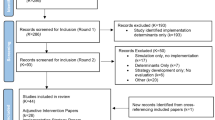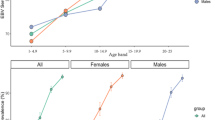Abstract
To evaluate the prevalence, trends, timing and duration of exposure to antiviral medications during pregnancy within a US cohort of pregnant women and to evaluate the proportion of deliveries with a viral infection diagnosis among women given antiviral medication during pregnancy. Live-born deliveries between 2001 and 2007, to women aged 15–45 years, were included from the Medication Exposure in Pregnancy Risk Evaluation Program, a collaborative research program between the U.S. Food and Drug Administration and eleven health plans. They were evaluated for prevalence, timing, duration, and temporal trends of exposure to antiviral medications during pregnancy. We also calculated the proportion of deliveries with a viral infection diagnosis among those exposed to antiviral medications. Among 664,297 live births, the overall prevalence of antiviral exposure during pregnancy was 4 % (n = 25,155). Between 2001 and 2007, antiviral medication exposure during pregnancy doubled from 2.5 to 5 %. The most commonly used antiviral medication was acyclovir, with 3 % of the deliveries being exposed and most of the exposure occurring after the 1st trimester. Most deliveries exposed to antiviral medications were exposed for less than 30 days (2 % of all live births). Forty percent of the women delivering an infant exposed to antiviral medications had a herpes diagnosis. Our findings highlight the increased prevalence of women delivering an infant exposed to antiviral medications over time. These findings support the need for large, well-designed studies to assess the safety and effectiveness of these medications during pregnancy.


Similar content being viewed by others
References
Reddick, K. L., Jhaveri, R., Gandhi, M., James, A. H., & Swamy, G. K. (2011). Pregnancy outcomes associated with viral hepatitis. Journal Viral Hepatitis, 18(7), e394–e398.
Safir, A., Levy, A., Sikuler, E., & Sheiner, E. (2010). Maternal hepatitis B virus or hepatitis C virus carrier status as an independent risk factor for adverse perinatal outcome. Liver International, 30(5), 765–770.
Musana, J. W., Ojwang, S. B., Khisa, W., & Kiarie, J. N. (2009). Pregnancy outcomes in mothers with advanced human immunodeficiency virus disease. East African Medical Journal, 86(10), 480–485.
Cervantes-Gonzalez, M., & Launay, O. (2010). Pandemic influenza A (H1N1) in pregnant women: Impact of early diagnosis and antiviral treatment. Expert Review Anti-Infective Therapy, 8(9), 981–984.
Jimenez, M. F., El Beitune, P., Salcedo, M. P., Von Ameln, A. V., Mastalir, F. P., & Braun, L. D. (2010). Outcomes for pregnant women infected with the influenza A (H1N1) virus during the 2009 pandemic in Porto Alegre Brazil. International Journal Gynaecology and Obstetrics, 111(3), 217–219.
Yates, L., Pierce, M., Stephens, S., Mill, A. C., Spark, P., Kurinczuk, J. J., et al. (2010). Influenza A/H1N1v in pregnancy: An investigation of the characteristics and management of affected women and the relationship to pregnancy outcomes for mother and infant. Health Technology Assessment, 14(34), 109–182.
Pol, S., Corouge, M., & Fontaine, H. (2011). Hepatitis B virus infection and pregnancy. Clinics and Research in Hepatology Gastroenterology, 35(10), 618–622.
Anzivino, E., Fioriti, D., Mischitelli, M., Bellizzi, A., Barucca, V., Chiarini, F., et al. (2009). Herpes simplex virus infection in pregnancy and in neonate: Status of art of epidemiology, diagnosis, therapy and prevention. Virology Journal, 6, 40.
Pasternak, B., & Hviid, A. (2010). Use of acyclovir, valacyclovir, and famciclovir in the first trimester of pregnancy and the risk of birth defects. JAMA, 304(8), 859–866.
Andrade, S. E., Davis, R. L., Cheetham, T. C., Cooper, W. O., Li, D. K., Amini, T., et al. (2011). Medication exposure in pregnancy risk evaluation program. Maternal and Child Health Journal, 16(7), 1349–1354.
Martin, J.A., Hamilton, B.E., Sutton, P.D., Ventura, S.J., Mathews, T.J., Kirmeyer, S., & Osterman, M.J.K. Births: Final data for 2007. 2010 Contract No.: 24.
Cooper, W. O., Hernandez-Diaz, S., Arbogast, P. G., Dudley, J. A., Dyer, S., Gideon, P. S., et al. (2006). Major congenital malformations after first-trimester exposure to ACE inhibitors. New England Journal of Medicine, 354(23), 2443–2451.
Li, Q., Andrade, S. E., Cooper, W. O., Davis, R. L., Dublin, S., Hammad, T. A., Pawloski, P. A., et al. Validation of an algorithm to estimate gestational age in electronic health plan databases. Pharmacoepidemiology and Drug Safety (in press).
Raebel, M. A., Ellis, J. L., & Andrade, S. E. (2005). Evaluation of gestational age and admission date assumptions used to determine prenatal drug exposure from administrative data. Pharmacoepidemiology and Drug Safety, 14(12), 829–836.
Toh, S., Mitchell, A. A., Werler, M. M., & Hernandez-Diaz, S. (2008). Sensitivity and specificity of computerized algorithms to classify gestational periods in the absence of information on date of conception. American Journal of Epidemiology, 167(6), 633–640.
Xu, F., Sternberg, M.R., Kottiri, B.J., McQuillan, G.M., Lee, F.K., Nahmias, A.J., Berman, S.M., & Markowitz, L.E. (2006) Trends in herpes simplex virus type 1 and type 2 seroprevalence in the United States. JAMA: The Journal of the American Medical Association. [Research Support, U.S. Gov’t, P.H.S.] 296(8):964-73.
Mills, J. L., & Carter, T. C. (2010). Acyclovir exposure and birth defects: an important advance, but more are needed. JAMA, 304(8), 905–906.
Stone, K. M., Reiff-Eldridge, R., White, A. D., Cordero, J. F., Brown, Z., Alexander, E. R., et al. (2004). Pregnancy outcomes following systemic prenatal acyclovir exposure: Conclusions from the international acyclovir pregnancy registry, 1984–1999. Birth Defects Research. Part A, Clinical and Molecular Teratology, 70(4), 201–207.
Moore, H. L, Jr, Szczech, G. M., Rodwell, D. E., Kapp, R. W, Jr, de Miranda, P., & Tucker, W. E, Jr. (1983). Preclinical toxicology studies with acyclovir: teratologic, reproductive and neonatal tests. Fundamental and Applied Toxicology, 3(6), 560–568.
Chahoud, I., Stahlmann, R., Bochert, G., Dillmann, I., & Neubert, D. (1988). Gross-structural defects in rats after acyclovir application on day 10 of gestation. Archives of Toxicology, 62(1), 8–14.
ACOG Practice Bulletin. (2007). Clinical management guidelines for obstetrician-gynecologists. No. 82 June 2007. Management of herpes in pregnancy. Obstetrics and Gynecology, 109(6), 1489–1498.
Acknowledgments
Financial Support: Participation on this study by Lyndsay Avalos was funded by UCSF-Kaiser/DOR Building Interdisciplinary Research Careers in Women’s Health Program (K12HD052163, NICHD/NIH, Guglielmo, PI). Sascha Dublin was funded by grant K23AG028954 from the National Institute on Aging. This study was also supported through funding from contracts HHSF223200510012C, HHSF223200510009C, and HHSF223200510008C from the U.S. Food and Drug Administration (Office of Surveillance and Epidemiology, Center for Drug Evaluation and Research).
Author information
Authors and Affiliations
Corresponding author
Additional information
The views expressed in this paper are those of the authors and are not intended to convey official US Food and Drug Administration (FDA) policy or guidance. The content is solely the responsibility of the authors and does not necessarily represent the official views of the National Institutes of Health.
Rights and permissions
About this article
Cite this article
Avalos, L.A., Chen, H., Yang, C. et al. The Prevalence and Trends of Antiviral Medication Use During Pregnancy in the US: A Population-Based Study of 664,297 Deliveries in 2001–2007. Matern Child Health J 18, 64–72 (2014). https://doi.org/10.1007/s10995-013-1234-9
Published:
Issue Date:
DOI: https://doi.org/10.1007/s10995-013-1234-9




